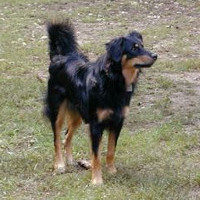Appearance of the English Shepherd
|
| English Shepherds are similar in appearance to Border Collies and Australian Shepherds. English Shepherds generally have a less rounded tail and head than many Australians. English Shepherds are never like Australians. They are generally not square in body like an Australian. English Shepherds tend to be larger than Border Collies, but are more easily distinguished from Border Collies by their very different, straight and loose style of guarding. The English Shepherd is a medium-sized dog, usually a little longer than it is tall. They generally weigh between 20 and 30 kilograms, and their proportions are well balanced. As working dogs on small farms, English Shepherds have been selected to meet a variety of needs. This has resulted in a wide variety of regional variations. The coat is of medium length and may be straight, wavy or curly. Bangs are frequently present on the legs and tail, as well as on the ear. As a working dog, the coat should be easy to keep, requiring very little grooming. Dirt tends to fall out. English Shepherds tend to shed a lot, and fur can be found on and under furniture, clothes and carpets. The main coat colors are sand and white (light and shaded), tricolor, black and white and black and tan. Other variations, such as plain or all-colored dogs, piebalds, red-nosed tricolors and sables also exist but are not common. |
Temperament of the English Shepherd
|
| The English Shepherd's temperament is the defining characteristic of the breed, with great intelligence and often a type of kindness unique to human beings, as in him. The English Shepherd is often an independent worker. English Shepherds are adaptable and learn routines quickly. Some can be attentive to strangers and are more of a one-person dog. However, once they accept people or children or animals as their own, there are few better guardians than an English Shepherd. The English Shepherd frequently shows a tendency in its temperament towards independent, authoritarian or rule-abiding rule. If the dog's desire to enforce order is not channeled and directed toward an appropriate goal by a strong, confident leader, it can exhibit many undesirable behaviors. Nevertheless, English Shepherds can thrive as companion dogs in environments offering sufficient mental and physical stimulation. English Shepherds require a lot of exercise, at least 40 minutes of walking a day, and can become destructive if not sufficiently fed. They have a natural instinct for hunting and enjoy playing a game of fetch. They tend to become calm and relaxed at the end of the day, likely to curl up at their owner's feet. This breed has already been selected from a number of small family farms, and has been chosen to work in partnership with its owner. |
Needs and activities of the English Shepherd
|
| This dog is wired to be energetic, needing to work and work hard. If the English Shepherd doesn't get enough exercise, he can become a barker and will chew up anything in sight. An active family that likes to hike, bike or run is ideal for this dog, or a small farm plot where he can hone his skills herding their flock or people. This dog also does well as a therapy dog, or in search and rescue. As a breed, they like to keep busy. They're also very playful and will enjoy family games, make excellent pets or buddies for children, and enjoy tasks that require them to solve a problem. This is a dog that loves mental stimulation. Hide their food in a toy and watch how they find it to take care of themselves. This active dog needs a lot of socialization as a puppy, to grow and gain confidence. They're often good with other pets, as well as trying to keep them, of course. And they tend to be incredibly patient and caring with young children, picking them up and guiding them. If you can't give your English Shepherd two or three long walks every day or lots of activity, then it's not a good choice. But if you like running or living on a farm, then the English Shepherd will be your faithful and trusted companion for life. |
Maintenance of the English Shepherd
|
| The English Shepherd needs a little attention when it comes to his appearance, as his dense coat seems to shed almost all the time. If you don't like dog hair in the house, and you don't like vacuuming, this is not the dog for you. However, giving your dog two or three hair grooming sessions a week will help alleviate the problem. English Shepherds don't need regular baths, only when they've been out in the mud or rolled in something unpleasant. Using a gentle dog shampoo will help maintain the natural oil balance in the dog's skin and help prevent allergies caused by harsh products. Other points to check are your dog's teeth. They can have tooth decay just like ours, so check those pearly teeth carefully and brush them at least twice a week. If you smell something unpleasant in your dog, it could be an ear infection. These infections can produce a horrible smell, not to mention the condition can worsen your dog's health, so it's important to check their ears regularly and wipe them with a soft, damp cloth. The final task is to give your dog a manicure if they haven't worn down their nails naturally. Ask a vet to show you how to do it properly so as not to hurt your dog. Then, all they need is a cuddle and they'll be nice and soft, just like a teddy bear. |











 English (United Kingdom)
English (United Kingdom)